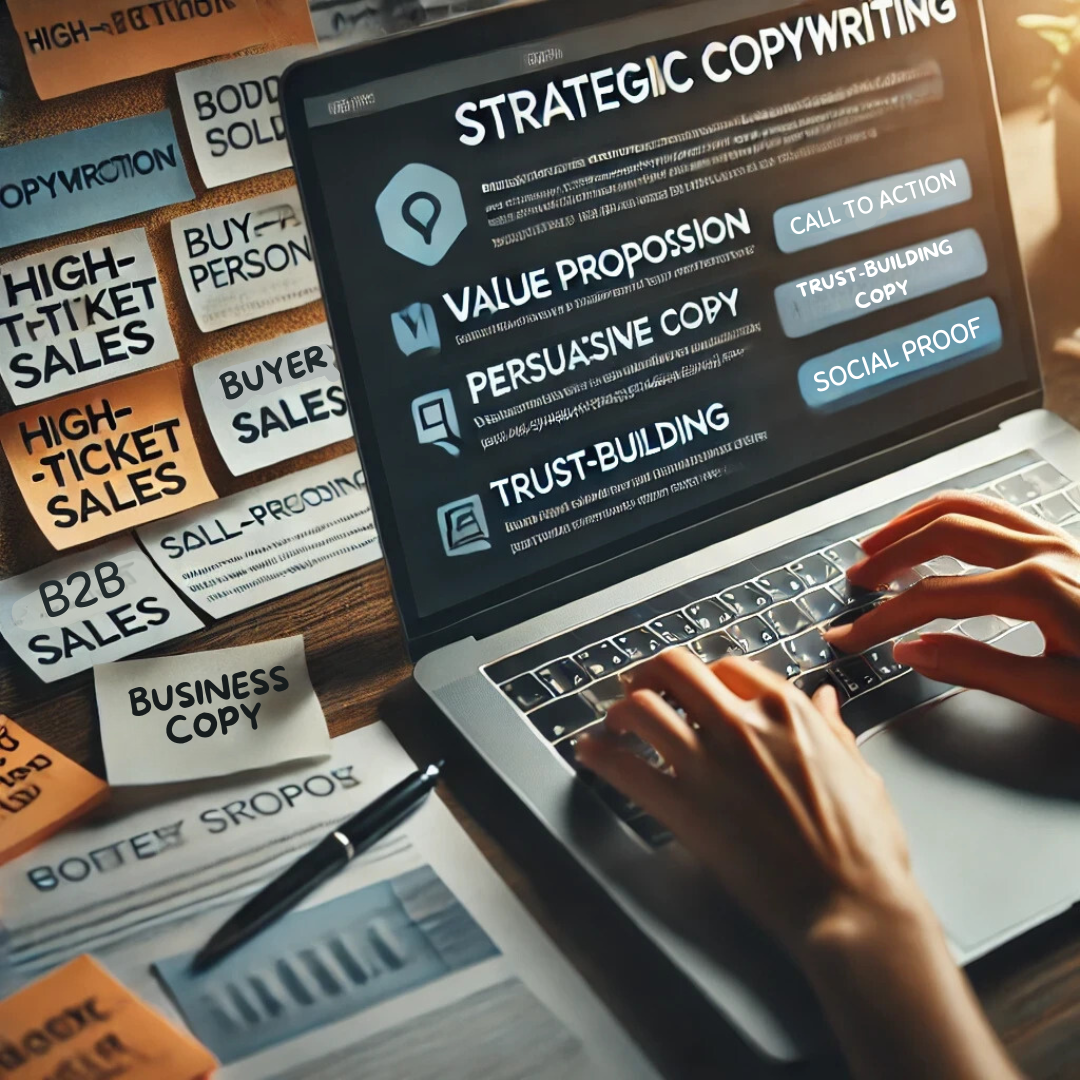Why High-Ticket B2B Sales Demand a Strategic Copywriting Approach
Securing high-ticket B2B sales plays a crucial role in driving significant revenue and fostering long-term partnerships, making them essential for a company’s growth. These large-scale deals require not only a deep understanding of client needs but also a strategic approach to successfully close them. One of the most powerful tools in this process is persuasive copywriting, especially when it aligns seamlessly with a tailored marketing strategy. When used effectively, this combination helps businesses attract high-value clients, build trust, and ultimately close high-ticket deals. In this article, we’ll explore how copywriting and marketing work together to craft compelling messages that influence decision-makers and drive successful sales outcomes.
What Sets High-Ticket B2B Sales Apart—and Why They Matter
In the B2B space, a high-ticket sale typically refers to a transaction involving a significant investment from the buyer, often characterized by long sales cycles, large deal sizes, and the involvement of multiple decision-makers. These deals usually involve complex products or services that require careful consideration, making the decision-making process more intricate. Trust becomes a critical factor in high-ticket sales, as buyers are often risk-averse and need reassurance that they are making the right choice. Unlike low-ticket sales, which tend to be more transactional and immediate, high-ticket deals demand relationship-building and nurturing over an extended period. Establishing credibility and providing value consistently throughout the sales journey is key to earning the trust necessary for closing these high-stakes transactions.
The Secret Weapon for Closing High-Ticket B2B Deals: Persuasive Copywriting
Persuasive copywriting plays an essential role in high-ticket B2B sales by communicating value, building trust, and establishing authority with decision-makers. In a competitive market, the right messaging helps your offer stand out while guiding prospects through the sales process. Effective copywriting doesn’t just describe your product or service—it demonstrates why your solution is superior by clearly articulating benefits and showcasing expertise.
In B2B, trust is everything, and precise, thoughtful copy can help establish that trust early on. High-value sales often involve multiple stakeholders, and each one needs to feel confident in the decision. By addressing concerns, highlighting the value proposition, and demonstrating deep knowledge, persuasive copy can provide the reassurance that prospects are making a sound, low-risk choice.
A powerful example of how persuasive copywriting can drive high-ticket B2B deals comes from ELM Learning, an eLearning agency that successfully rebranded to differentiate itself in a crowded industry. By aligning their copywriting with a strategic marketing approach, ELM shifted their messaging to focus on their unique NeuroLearning methodology, emphasizing both emotional and rational benefits. This new narrative not only highlighted their innovative approach but also resonated deeply with high-level decision-makers. The result was a 60% increase in opportunities within the first 30 days of their brand relaunch, leading to multiple high-profile enterprise accounts. This case illustrates how strategically crafted, persuasive copy can effectively cut through the noise and build trust with high-value clients
How to Harmonize Copywriting and Marketing for Maximum Sales Impact
Aligning your copy with your broader marketing strategy is critical for successfully closing high-ticket B2B deals. Consistency between your sales, marketing, and copywriting efforts ensures that your message resonates at every touchpoint along the buyer’s journey. When these departments are aligned, it creates a unified voice that builds trust with prospects and strengthens your brand’s credibility. As discussed in our recent blog article on sales and marketing alignment between these teams is essential for delivering a seamless experience to potential clients.
Copywriting is not just about delivering information—it’s a strategic marketing tool that can enhance lead generation, nurture relationships, and push prospects closer to closing the deal. Well-crafted copy helps bridge the gap between a prospect’s awareness and decision-making stages by addressing their concerns and providing the right value at the right time. By speaking directly to buyer pain points and offering tailored solutions, your messaging becomes more relevant to high-level decision-makers, making them more likely to trust your brand and engage further. Ultimately, aligning your copy with your marketing strategy strengthens your ability to convert leads into high-ticket clients.
Speak to Their Needs: Crafting Copy That Resonates with High-Level Buyers
Creating buyer-centric copy is essential when positioning high-ticket B2B offers. The first step is understanding the buyer’s pain points, which requires a deep dive into buyer personas. By developing clear personas, you can craft copy that directly addresses the unique challenges and goals of each decision-maker involved in the purchasing process. Tailored messaging ensures that your copy resonates with those high-level executives, making it more relevant and compelling.
To engage C-suite or senior decision-makers, it’s crucial to present a clear and compelling value proposition. This means going beyond listing product features and focusing on the specific outcomes your solution delivers. Highlighting the strategic benefits—whether it’s increased efficiency, cost savings, or business growth—helps these leaders see how your offer aligns with their broader goals. A strong value proposition should not only emphasize what makes your solution unique but also clearly communicate the impact it will have on their business.
Additionally, preemptively addressing objections is key to building trust. Whether it’s concerns about ROI, implementation, or long-term viability, providing proof points such as case studies, client testimonials, and concrete data can help alleviate doubts. Storytelling can also be an effective way to show how others in similar positions have successfully implemented your solution and achieved measurable results. By overcoming these objections upfront, you make it easier for buyers to feel confident about investing in your high-ticket offer.
Build Trust with Social Proof: How to Showcase Your B2B Success Stories
In high-ticket B2B sales, incorporating social proof and authority into your copy is essential for establishing trust and reassuring potential buyers of your brand’s credibility. Case studies, testimonials, and data-backed results are powerful tools that provide tangible evidence of your capabilities. They allow prospects to see how your solution has delivered results for others, especially when those others are in similar industries or have faced comparable challenges. By showcasing real-world outcomes, you reduce perceived risk and help decision-makers feel more confident in their choice.
Authority markers, such as industry awards, mentions in reputable publications, or partnerships with well-known clients, further strengthen your position as a trusted provider. These elements add an extra layer of credibility to your messaging, signalling that your brand is recognized and respected within the industry. Thought leadership, whether through articles, speaking engagements, or leadership in key projects, also demonstrates that you’re ahead of the curve and capable of delivering innovative, high-value solutions.
When incorporating social proof, it’s important to avoid overtly promotional language. Subtle selling is key. Use testimonials or case studies as supporting evidence rather than the main message, allowing them to naturally reinforce the value of your offering. By letting satisfied clients speak to your expertise and success, you build trust without appearing pushy, positioning your brand as the obvious choice for high-ticket buyers looking for a reliable, results-driven partner.
Guiding Prospects to the Finish Line: How to Nurture High-Ticket Leads
Nurturing leads through the sales funnel is a critical process in converting high-ticket B2B prospects into loyal clients. The buyer’s journey typically consists of three stages: awareness, consideration, and decision. During the awareness stage, prospects are just identifying their challenges and exploring potential solutions. In the consideration stage, they’re evaluating different options, and by the decision stage, they are weighing the final choices and preparing to make a commitment.
To guide prospects through these stages, effective nurture campaigns are essential. This is where tools like email sequences, blog posts, and landing pages come into play. Each piece of content should be designed to meet prospects where they are in their journey and provide the right information to move them closer to a decision. For example, educational blog posts can be used to attract attention during the awareness stage, while case studies and detailed product comparisons can help prospects in the consideration phase. Landing pages tailored to specific pain points can further engage decision-makers as they evaluate your solution.
Email nurture sequences are particularly powerful in keeping your brand top of mind. As outlined in our blog article on building a B2B email marketing strategy, each email should be crafted with a clear objective, whether it’s educating the prospect, addressing common objections, or offering proof points. Messaging should evolve as prospects move through the funnel—starting with broader industry insights in the awareness stage, transitioning to solution-based content in the consideration stage, and finally, providing detailed ROI data or client testimonials during the decision-making phase. By tailoring your content to each stage of the journey, you ensure that prospects receive relevant, persuasive messaging that supports their decision to invest in your high-ticket offer.
Balancing Emotion and Logic to Win Over B2B Decision-Makers
In high-ticket B2B sales, an effective copy balances both emotional and logical appeals to engage buyers on multiple levels. Emotional motivators—such as the desire for security, fear of missing out on growth opportunities, or the ambition to be seen as a leader in the industry—can play a significant role in the decision-making process, even for the most rational buyers. Storytelling is a powerful way to tap into these emotions, showing how your solution not only solves a problem but also helps the buyer achieve their broader business goals. For example, positioning your product as the key to safeguarding a company’s future or accelerating its competitive edge can spark an emotional connection.
However, emotional appeals alone aren’t enough in the B2B world, where decision-makers must also justify their choices with clear, logical evidence. This is where data, ROI projections, and well-structured benefits come into play. After appealing to emotions, backing up your claims with hard numbers and detailed explanations helps reassure buyers that your solution is a sound, low-risk investment. For example, if your product promises efficiency gains, provide real case studies or statistics to prove it.
The most effective high-ticket sales copy finds the right balance between emotion and logic. An example might be, “By choosing our platform, you’ll not only streamline operations and reduce costs by 30%—as proven in our case study with Company X—but also position your company as a forward-thinking leader in your industry, ready to scale for future growth.” This combination of emotional engagement and logical reasoning ensures that buyers feel both inspired and confident in their decision to move forward.
Encouraging Action: Creating CTAs That Drive High-Ticket Engagement
Crafting effective call-to-actions (CTAs) for high-ticket B2B sales requires a more strategic and subtle approach compared to lower-ticket offers. Since these deals involve higher stakes and multiple decision-makers, an aggressive or pushy CTA can turn prospects away. Instead, it’s better to use non-aggressive CTAs that encourage prospects to take the next step—like booking a demo or scheduling a consultation—without feeling pressured. The goal is to guide them towards engagement rather than force a decision prematurely.
For example, instead of using a direct “Buy Now” or “Sign Up Today” CTA, consider softer alternatives such as “Explore how our solution fits your business” or “Let’s discuss how we can help you achieve your goals.” These types of CTAs invite prospects to learn more and engage at their own pace, which is crucial when dealing with high-ticket offers that require careful consideration.
When it comes to CTA placement and frequency, it’s important to strike a balance. Including CTAs in key locations—such as at the end of a compelling section or after presenting a strong value proposition—ensures they appear naturally within the flow of your content. However, overloading your copy with CTAs can overwhelm or distract prospects, so it’s best to use them sparingly and strategically. By pacing CTAs thoughtfully, you create opportunities for engagement without disrupting the buyer’s journey or appearing too eager to close the deal.
Conclusion: Elevate Your B2B Sales with Persuasive, Strategic Copywriting
Persuasive copywriting plays a vital role in closing high-ticket B2B sales by engaging decision-makers, building trust, and clearly communicating the value of your offering. It’s more than just words—it’s about crafting a strategic message that aligns with your marketing and sales efforts to guide prospects through the buyer’s journey. Now is the perfect time to take a fresh look at your own copywriting and marketing strategies. Are they truly working together to attract, nurture, and close high-value deals?
If you’re looking to refine your messaging and align it more effectively with your high-ticket sales strategy, we’d love to help you craft copy that delivers results. We provide tailored copywriting and content services specifically for B2B businesses to support your growth. Discover more here.



